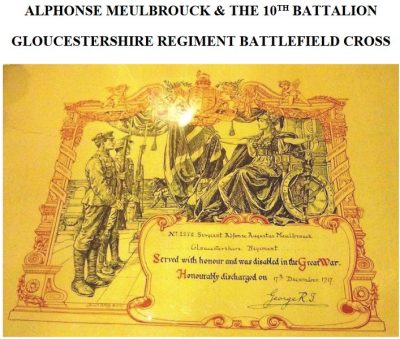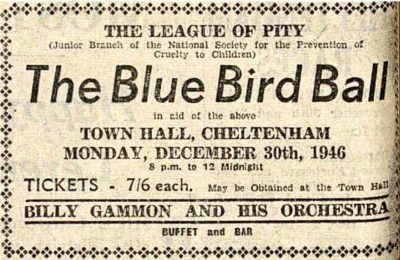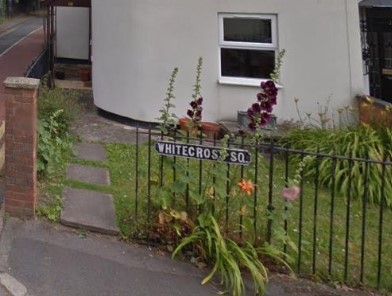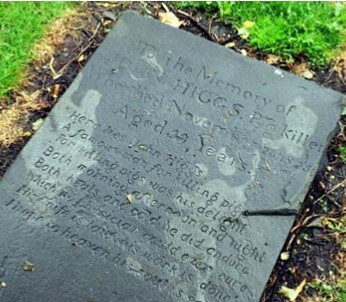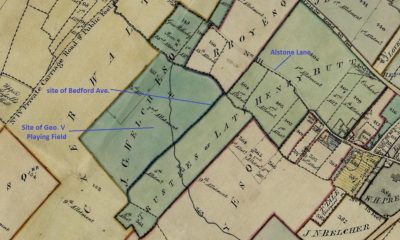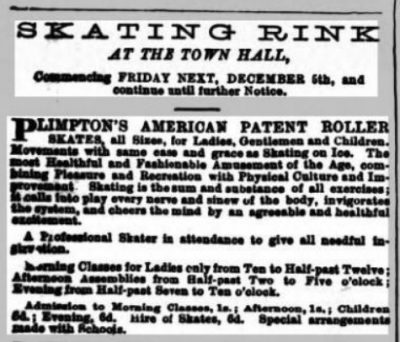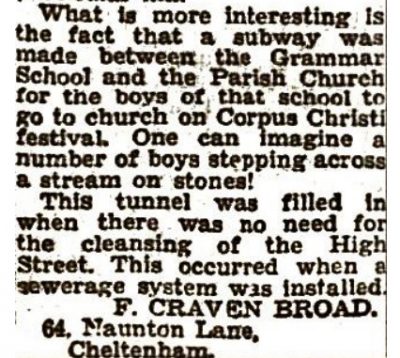Research articles
These are Local History articles contributed by members. Also included are a number of responses to local history research enquiries investigated by Jill Waller. Copyright is owned by the authors. Please refer to our Copyright section before reproducing any of the material on this website.
JOHN DOWER HOUSE AND LATHERAM HOUSE – WHAT CAME BEFORE: A tribute to the late James Hodsdon
An introduction by Judie Hodsdon: James had long been particularly interested in the part of Cheltenham south of the Library and the Wilson. It was the site of the medieval manor court, the records of whose proceedings James spent many hours translating, transcribing and editing, producing a B&GAS Records Series volume and several articles. In researching the history of Cheltenham as a Spa and the life of Captain Skillicorne, the area’s significance only increased as it was the location of Lady Stapleton’s Great House, the first large house erected in the town marking its growing importance as a resort. With its decline as a Spa Cheltenham became and of course remains a place attracting those seeking retirement in pleasant surroundings, and a development of apartments for ‘later living’, Latheram House, was built in what had been the garden of the Great House. On deciding to downsize, Latheram House was obviously the place for us and James set about putting together a booklet about the history of the site for the benefit of residents and others.
You may use the material on this website for your own private research purposes but not for publication in any format.
Text is copyright of Cheltenham Local History Society and/or the author(s), and all illustrations are copyright to the copyright owners. Neither text nor illustrations may be reproduced, stored in a retrieval system or transmitted by any means without the prior permission in writing of the owner or owners. We apologise if any material infringes copyright or has not been acknowledged. The Society will gladly acknowledge any omissions, if informed.
No material from this website may be reproduced in any format without permission from the copyright holder(s) and due acknowledgement of the same. Please use our Contact Form for any queries.
ALBERT VILLA, 3 SELKIRK STREET: ITS OCCUPANTS by Jill Waller
Albert Villa was built c.1840-41, probably by William Morgan. The first occupier was Wardle Eastland Evans (1810-1884), a musician. Born in Margate, Wardle married a Cheltenham baker’s daughter, Sarah Watcham, in 1838. Besides teaching, W.E. Evans was a skilled craftsman and inventor who did much to advance the of harmonium building in England. He designed the ‘New English Harmonium’, from 1843, producing many patents for improvements to the instrument. Henry Willis (1820-1901), later to become one of the greatest English pipe organ builders of the 19th century, worked with W.E. Evans in Cheltenham from 1842-45. Around this time (1844) Evans restored the pipe organ in St. Peter’s, Winchcombe. Evans exhibited harmoniums at the Paris 1867 Exhibition, among others.
You may use the material on this website for your own private research purposes but not for publication in any format.
Text is copyright of Cheltenham Local History Society and/or the author(s), and all illustrations are copyright to the copyright owners. Neither text nor illustrations may be reproduced, stored in a retrieval system or transmitted by any means without the prior permission in writing of the owner or owners. We apologise if any material infringes copyright or has not been acknowledged. The Society will gladly acknowledge any omissions, if informed.
No material from this website may be reproduced in any format without permission from the copyright holder(s) and due acknowledgement of the same. Please use our Contact Form for any queries.
ALFRED TENNYSON LIVED HERE – OCCASIONALLY by Joanna Vials and Christopher Bentall
A few months ago as I stood at the bus stop in St James Square a gentleman came along the pavement alongside St Gregory’s Church and peered intently over the wall at the presbytery, No 10. He walked inside the gate and looked again. ‘I’ve read everything I can on Alfred Tennyson and I can’t find anything that says he lived here,’ he told me.
You may use the material on this website for your own private research purposes but not for publication in any format.
Text is copyright of Cheltenham Local History Society and/or the author(s), and all illustrations are copyright to the copyright owners. Neither text nor illustrations may be reproduced, stored in a retrieval system or transmitted by any means without the prior permission in writing of the owner or owners. We apologise if any material infringes copyright or has not been acknowledged. The Society will gladly acknowledge any omissions, if informed.
No material from this website may be reproduced in any format without permission from the copyright holder(s) and due acknowledgement of the same. Please use our Contact Form for any queries.
ALPHONSE MEULBROUCK & THE 10TH BATTALION GLOUCESTERSHIRE REGIMENT BATTLEFIELD CROSS by Chris Bentall
Among the exhibits on view at the CLHS History Afternoon in St Matthews Church on 19 July 2014 was an item minded by Steven Blake (former Deputy Director and Keeper of Social History of Cheltenham Art Gallery & Museums): a single page, about A3 in size, dating from World War 1, with the following citation ‘No2250 Sergeant Alphonse Augustus Meulbrouck, Gloucestershire Regiment Served with honour and was disabled in the Great War.Honourably discharged on 17th December 1917.
You may use the material on this website for your own private research purposes but not for publication in any format.
Text is copyright of Cheltenham Local History Society and/or the author(s), and all illustrations are copyright to the copyright owners. Neither text nor illustrations may be reproduced, stored in a retrieval system or transmitted by any means without the prior permission in writing of the owner or owners. We apologise if any material infringes copyright or has not been acknowledged. The Society will gladly acknowledge any omissions, if informed.
No material from this website may be reproduced in any format without permission from the copyright holder(s) and due acknowledgement of the same. Please use our Contact Form for any queries.
THE BLUE BIRD BALL by Jill Waller
Held annually at Cheltenham Town Hall in aid of the League of Pity (NSPCC)
The NSPCC was founded in the 1889s, from the earlier London SPCC. In 1891 a junior branch, the League of Pity, was founded to allow children to learn about the NSPCC and support fund-raising initiatives. A Cheltenham branch of the League of Pity was established in 1929, and held an annual ball at the Town Hall from the early 1930s.
You may use the material on this website for your own private research purposes but not for publication in any format.
Text is copyright of Cheltenham Local History Society and/or the author(s), and all illustrations are copyright to the copyright owners. Neither text nor illustrations may be reproduced, stored in a retrieval system or transmitted by any means without the prior permission in writing of the owner or owners. We apologise if any material infringes copyright or has not been acknowledged. The Society will gladly acknowledge any omissions, if informed.
No material from this website may be reproduced in any format without permission from the copyright holder(s) and due acknowledgement of the same. Please use our Contact Form for any queries.
CHELTENHAM CROSSES AND CROSSROADS by James Hodsdon
Older records refer to several different crosses in Cheltenham, all now lost, so their nature and location can be hard to pinpoint. Were they substantial structures, were they sign-posts (like that still commemorated by the Cross Hands Inn on the Tewkesbury Road) – or were they no more than notable road junctions?
You may use the material on this website for your own private research purposes but not for publication in any format.
Text is copyright of Cheltenham Local History Society and/or the author(s), and all illustrations are copyright to the copyright owners. Neither text nor illustrations may be reproduced, stored in a retrieval system or transmitted by any means without the prior permission in writing of the owner or owners. We apologise if any material infringes copyright or has not been acknowledged. The Society will gladly acknowledge any omissions, if informed.
No material from this website may be reproduced in any format without permission from the copyright holder(s) and due acknowledgement of the same. Please use our Contact Form for any queries.
HINGES IN A MONTPELLIER FLOWERBED by Jill Waller
I recently received an enquiry about some large hinges noticed in the flowerbed that runs along the NE side of Montpellier Gardens, below the King William IV statue. I took my camera to investigate, hoping that the hinges may have something to do with a long-lost Montpellier Gardens saline well.
You may use the material on this website for your own private research purposes but not for publication in any format.
Text is copyright of Cheltenham Local History Society and/or the author(s), and all illustrations are copyright to the copyright owners. Neither text nor illustrations may be reproduced, stored in a retrieval system or transmitted by any means without the prior permission in writing of the owner or owners. We apologise if any material infringes copyright or has not been acknowledged. The Society will gladly acknowledge any omissions, if informed.
No material from this website may be reproduced in any format without permission from the copyright holder(s) and due acknowledgement of the same. Please use our Contact Form for any queries.
JOHN HIGGS, c.1788-1825, FAMOUS MAN FOR KILLING PIGS by Jill Waller
To the Memory of JOHN HIGGS, Pig Killer, who died November 28th 1825, Aged 55 years.
Here lies John Higgs / A famous man for killing pigs / For killing pigs was his delight / Both morning, afternoon and night. / Both heats and cold he did endure / Which no physician could e’er cure. / His knife is laid, his work is done / I hope to heaven his soul is gone.
Many visitors to Cheltenham Minster churchyard must have wondered about this well-known epitaph. John Higgs was indeed a pig-killer, successful and proud of his chosen profession.
You may use the material on this website for your own private research purposes but not for publication in any format.
Text is copyright of Cheltenham Local History Society and/or the author(s), and all illustrations are copyright to the copyright owners. Neither text nor illustrations may be reproduced, stored in a retrieval system or transmitted by any means without the prior permission in writing of the owner or owners. We apologise if any material infringes copyright or has not been acknowledged. The Society will gladly acknowledge any omissions, if informed.
No material from this website may be reproduced in any format without permission from the copyright holder(s) and due acknowledgement of the same. Please use our Contact Form for any queries.
KING GEORGE V PLAYING FIELD, ROWANFIELD by Jill Waller
The King George V Playing Field sits in part of what was originally Hill Field in the hamlet of Alstone. For centuries this large field was divided into strip lynchets (ridge and furrow farming), the strip being allocated to a different people to farm. Gradually the land became enclosed with a number of strips being fenced together, and the end of ridge and furrow farming came to an end in the area with the 1835 Alstone Inclosure Award. Any remaining strip lynchet land was divided up into allotments which were awarded to the owners according to how many strips of land they had previously farmed.
You may use the material on this website for your own private research purposes but not for publication in any format.
Text is copyright of Cheltenham Local History Society and/or the author(s), and all illustrations are copyright to the copyright owners. Neither text nor illustrations may be reproduced, stored in a retrieval system or transmitted by any means without the prior permission in writing of the owner or owners. We apologise if any material infringes copyright or has not been acknowledged. The Society will gladly acknowledge any omissions, if informed.
No material from this website may be reproduced in any format without permission from the copyright holder(s) and due acknowledgement of the same. Please use our Contact Form for any queries.
THE MERCERS THE MASONS AND THE MARINER or TOKENS OF ESTEEM – 17th century tokens and the development of Cheltenham USA and UK by a prominent Quaker family who issued tokens by Neela Mann
It was a chance encounter with the owner of a piece of land in the centre of Cheltenham which eventually led to the purchase of my first 17th century token. The man had, he said, a bundle of papers pertaining to the land which he couldn’t decipher – a historian’s dream! The papers were deeds dating from 1682 to 1997, the latter date being when the owner’s father purchased the land.
You may use the material on this website for your own private research purposes but not for publication in any format.
Text is copyright of Cheltenham Local History Society and/or the author(s), and all illustrations are copyright to the copyright owners. Neither text nor illustrations may be reproduced, stored in a retrieval system or transmitted by any means without the prior permission in writing of the owner or owners. We apologise if any material infringes copyright or has not been acknowledged. The Society will gladly acknowledge any omissions, if informed.
No material from this website may be reproduced in any format without permission from the copyright holder(s) and due acknowledgement of the same. Please use our Contact Form for any queries.
OLAVE CHREIMAN, 1810-1886, CARVER & GILDER by Jill Waller
Olave Chreiman was born in Soho, London, on 28 Jul 1810, son of George Chreiman and Hannah née Griffiths. His father, George Chreiman, was a stay and corset maker. In 1811 the family moved to Cheltenham, where Olave’s youngest brother Henry was baptised on 20 Jan 1814. Over the following decades George Chreiman ran his corset business from various addresses along the High Street, at one time in partnership with his daughter Mary Elizabeth Cooke.
You may use the material on this website for your own private research purposes but not for publication in any format.
Text is copyright of Cheltenham Local History Society and/or the author(s), and all illustrations are copyright to the copyright owners. Neither text nor illustrations may be reproduced, stored in a retrieval system or transmitted by any means without the prior permission in writing of the owner or owners. We apologise if any material infringes copyright or has not been acknowledged. The Society will gladly acknowledge any omissions, if informed.
No material from this website may be reproduced in any format without permission from the copyright holder(s) and due acknowledgement of the same. Please use our Contact Form for any queries.
ROLLER SKATING IN CHELTENHAM 1873-1888 by Sue Rowbotham
Roller skating, or rinking as it was also called, was part of a worldwide craze known as rinkomania which began in the early 1860s. The earliest recorded use of roller skates was in 1743, but the design of these in-line skates did not allow the user to turn or stop efficiently. In January 1863 James Leonard Plimpton of Massachusetts, USA patented a revolutionary four-wheel skate which enabled the skater to turn corners safely.
You may use the material on this website for your own private research purposes but not for publication in any format.
Text is copyright of Cheltenham Local History Society and/or the author(s), and all illustrations are copyright to the copyright owners. Neither text nor illustrations may be reproduced, stored in a retrieval system or transmitted by any means without the prior permission in writing of the owner or owners. We apologise if any material infringes copyright or has not been acknowledged. The Society will gladly acknowledge any omissions, if informed.
No material from this website may be reproduced in any format without permission from the copyright holder(s) and due acknowledgement of the same. Please use our Contact Form for any queries.
ROLLING OUT THE WELCOME WAGON IN CHELTENHAM by Sue Rowbotham
The phrase ‘Rolling out the welcome wagon’ is defined in theCambridge English Dictionary as ‘a happy and friendly way of greeting people who are new to a place’1, as in ‘She likes to roll out the Welcome wagon for everyone who moves onto the block’. I have also seen it described as ‘A vehicle bringing gifts and samples from local merchants to newcomers in a community’.
You may use the material on this website for your own private research purposes but not for publication in any format.
Text is copyright of Cheltenham Local History Society and/or the author(s), and all illustrations are copyright to the copyright owners. Neither text nor illustrations may be reproduced, stored in a retrieval system or transmitted by any means without the prior permission in writing of the owner or owners. We apologise if any material infringes copyright or has not been acknowledged. The Society will gladly acknowledge any omissions, if informed.
No material from this website may be reproduced in any format without permission from the copyright holder(s) and due acknowledgement of the same. Please use our Contact Form for any queries.
A TUNNEL UNDER THE HIGH STREET? by Jill Waller
I have been unable to find any definitive evidence of a tunnel, or first-hand accounts, only hearsay.
You may use the material on this website for your own private research purposes but not for publication in any format.
Text is copyright of Cheltenham Local History Society and/or the author(s), and all illustrations are copyright to the copyright owners. Neither text nor illustrations may be reproduced, stored in a retrieval system or transmitted by any means without the prior permission in writing of the owner or owners. We apologise if any material infringes copyright or has not been acknowledged. The Society will gladly acknowledge any omissions, if informed.
No material from this website may be reproduced in any format without permission from the copyright holder(s) and due acknowledgement of the same. Please use our Contact Form for any queries.




